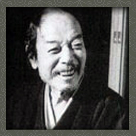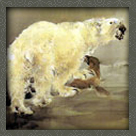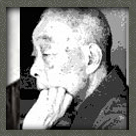|

|
Kanoh Hohgai |
|
Hashimoto Gaho |
 |
|
 |
|
Kanoh Hohgai was one of the founders of the Tokyo Fine Arts School. "Avalokiesvara
as a Merciful Mother", his last piece of work, shows how he broke new
ground of Japanese painting, applying chiaroscuro to the traditional
style of painting................ |
The artist, Hashimoto Gaho, was born in Edo (present-day Tokyo) in
1835. His father, who was also a painter, died when Hashimoto was 13.
In 1882, Hashimoto's work at an exhibition organized by the Meiji
government received recognition from Okakura Tenshin and Ernest ..... |
| |
|
|
|
|
|
Keinen Imao |
|
Kono Baitel |
 |
|
 |
|
Keinen Imao was born in Kyoto, his original name was Imao Isaburo. He
studied ukiyo-e painting with Umegata Tokyo and other Japanese styles
with Suzuki Hyakunen. In 1880, he began to teach as a professor at the
Kyoto Prefecture School of Painting. .................. |
Was one of the leading practitioners of the ukiyo-e school devoted to
pictures of birds and flowers (kacho-ga) in the Meiji period. He was
born and lived in Kyoto, the old Imperial capital of Japan, and was
originally named Yasuda Bairei. Unlike many other ukiyo-e artists, he
was trained as a classical Japanese
 |
| |
|
|
|
|
|
Taikan Yokoyama |
|
Hobun Kikuchi |
 |
|
 |
|
Taikan Yokoyama was born in the Mito District in 1868, the eldest son
of Sutehiko Sakai, a member of the samurai class of the Mito clan. In
1889, he entered the first graduating class of Tokyo Fine Art School
(now the Tokyo National University of Fine Arts and Music). From the
very potential. In 1898........ |
Hobun Kikuchi had studied with Kono Bairei. He worked as a painter and
print designer for kacho-e and landscapes. He was among the
established artists exhibiting at Bunten and Teiten. Hobun Kikuchi
taught at the Kyoto Citiy School of Fine Arts and Crafts.
......................... |
| |
|
|
|
|
|
Shunkyo
YAMAMOTO |
|
Seiho TAKEUCHI |
 |
|
 |
|
Born in Otsu City, Shiga Prefecture, in 1871.
studied under Kono Bairei, Nomura Bunkyo, and Mori Kansai.With
the traditional styles of the Maruyama-Shijo School as his foundation,
Shunkyo adopted techniques from Western painting and photography to
establish his own .......... |
When speaking of modern Japanese-style painting, the names Taikan
YOKOYAMA and Seiho TAKEUCHI always arise. These two painters
introduced European painting styles into traditional Japanese painting
and harmonized them. Seiho was born in Kyoto............. |
| |
|
|
|
|
|
Japanese Connection |
|
Gyokudo KAWAI |
 |
|
 |
|
Although the Lingnan School stresses renewal and creativity, its
essential spirit does not reside in rejection of traditional methods
and inspiration. Rather, we consider ourselves heirs of tradition and
we strive, clearly, toward a catholicity whic |
Born in Aichi Prefecture in 1873. Gyokudo was recognized as a great
painter from his childhood and joined the Nihon Bijutsuin upon its
establishment in 1898. He was appointed to the judgin |
| |
|
|
|
|
|
Shunso
HISHIDA |
|
Kanzan
SHIMOMURA |
 |
|
 |
|
Born in Nagano Prefecture in 1874. He studied under Tenshin OKAKURA
and Gaho HASHIMOTO at the Tokyo Art School. He also took part in the
establishment of the Nihon Bijutsuin along with Taikan YOKOYAMA and
others.
 |
Shimomura went to Tokyo in 1881 to study painting
and became a pupil of Kano Hogai and Hashimoto Gaho. One of the first
students to enter the Tokyo Fine Arts School, founded in 1889,
Shimomura joined its staff upon graduation,
 |
| |
|
|
|
|
|
Shoen UEMURA |
|
Nishimura
GOUN |
 |
|
 |
|
Shoen Uemura was born in Kyoto on April 23, 1875. Her real name was
Tsune Uemura. She had a strong interest in "Bijinga" drawings (images
portraying the beauty of women) over her entire lifetime, which
spanned the Meiji, Taisho and Showa eras. Her style involved ........ |
Goun Nishimura was born in Kyoto - the town of the old imperial
residence. He worked as a teacher for traditional Japanese painting at
the Kyoto City Specialist School of Painting. His favorite subjects
were natural life themes and actor scenes....................... |
| |
|
|
|
|
|
Kiyokata
KABURAKI |
|
Hyakusui Hirafuku |
 |
|
 |
|
Born in Kanda, Tokyo, in 1878. He was mentored by Toshikata MIZUNO, an
ukiyoe painter, and exhibited works at exhibitions such as the Bunten.
When the Teiten exhibition was established in 1919, he was appointed
juror. Was a member of ................... |
Born in Kakunodate in Akita Prefecture. After graduating from the
Tokyo School of Fine Arts, he founded the "Museikai" society and set
out to revolutionize Nihon-ga (Japanese style painting) with his
naturalistic style of Nihon-ga which incorporated Western
realism................... |
| |
|
|
|
|
|
Seison
MAEDA |
|
Kansetsu
HASHIMOTO |
 |
|
 |
|
Born in Gifu Prefecture in 1885. Through the introduction of Koyo
OZAKI, he was able to study under Hanko KAJITA, where he worked hard
at reproducing picture scrolls. He joined the Kojikai in 1907 and was
widely noticed as a rising artist when he was awarded a prize at
....... |
Born in Kobe in 1883. In his childhood, he studied sinology and basic
classes at the Shijo school. He then joined Chikujokai, a private
school led by Seiho TAKEUCHI, during which time he actively
participated in the Kanten exhibition. He later withdrew from
Chikujokai because
 |
| |
|
|
|
|
|
Shinsui
ITO |
|
Kayo
YAMAGUCHI |
 |
|
 |
|
Born in Tokyo in 1898. As a child, he began working at a print shop as
a printer and continued to do so while studying under Kiyokata
KABURAKI when he was 13. He later worked on illustrations and
woodblock prints. He was invited to exhibit at the Bunten exhibition
when he was only 17. .... |
Born in Kyoto in 1899. He studied painting under
Nishimura Goun. He exhibited mainly with the Kanten Exhibition while
studying at the Kyoto Municipal College of Painting and won
recognition from art circles early in his career. He taught at the
Kyoto Municipal Art College in 1942, and...................... |
| |
|
|
|
|
|
Kaii
HIGASHIYAMA |
|
Shoko
UEMURA |
 |
|
 |
|
Higashiyama Kaii was born on July 8th in Yokohama,
to parents Kosuke and Higashiyama Kaii. He was given the name
Shinkichi, but later changed this to Kaii. He lived from 3 years old
to 18 in Kobe. 1926 when it graduated from Hyogo prefectural Hyogo
high school, Higashiyama entered the Nihon-ga department of Tokyo
School ............. |
Shoko Uemura was born in Kyoto in 1902 as the first
son of female artist Shoen Uemura. Growing up at her side, Shoko was
naturally drawn to the artist path and was educated at Kyoto City Art
and Craft School, Kyoto City University of Painting,
..................................... |
| |
|
|
|
|
|